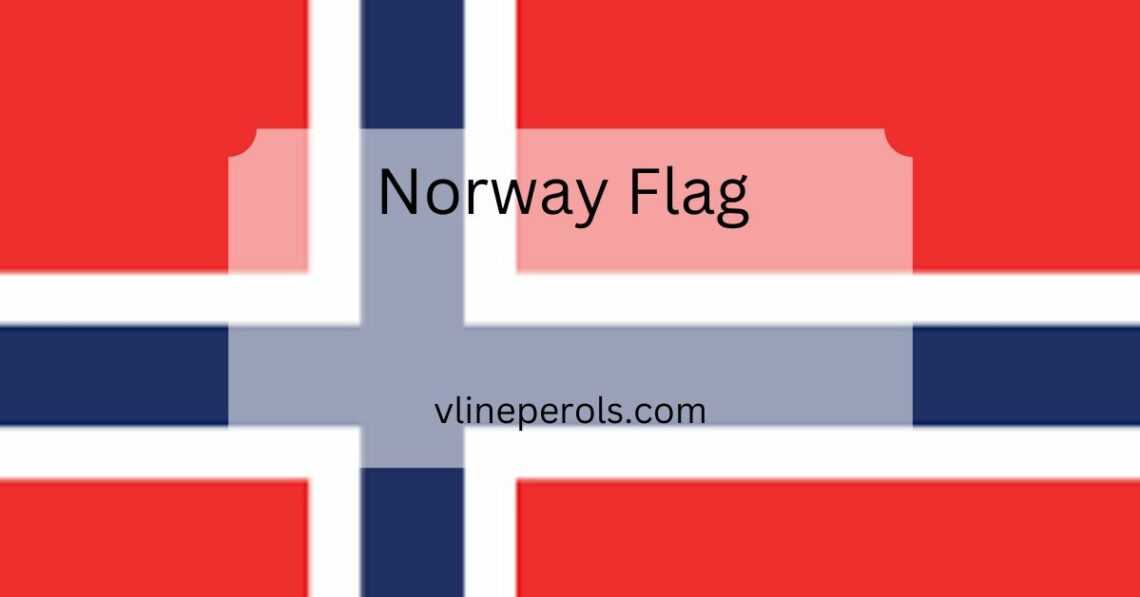
Norway Flag – A Complete Guide!
The Norway flag stands as an enduring symbol of national pride and unity, reflecting the rich heritage and values of the Norwegian people.
The Norway flag is a vibrant red field with a bold blue cross outlined in crisp white, symbolizing the Norwegian people’s enduring courage, purity, and unwavering loyalty.
This article will delve into the design, symbolism, cultural significance, and controversies surrounding the Norway flag, exploring its pivotal role in Norwegian society and its enduring impact on popular culture.
Table of Contents
What Is The Meaning Of Norway’s Flag – (For Those Who Don’t Know)
The flag of Norway holds deep symbolism that reflects the nation’s history, values, and aspirations. Its design consists of a red field with a blue cross outlined in white, evoking powerful imagery tied to Norway’s past.
The red color represents courage, strength, and the blood the country’s ancestors shed in their quest for independence and sovereignty.
The blue cross signifies Norway’s union with Sweden and Denmark, while the white border symbolizes purity, peace, and unity among its people. The flag embodies Norway’s resilience, patriotism, and commitment to freedom and democracy.
The flag is a proud emblem of Norwegian identity, unity, and heritage, inspiring citizens to uphold the nation’s values and traditions.
Its simple yet powerful design resonates deeply with Norwegians, symbolizing their enduring spirit and unwavering dedication to a brighter future.
Historical Background Of Norway’s Flag – Dive In It!
The historical background of the Norway flag dates back to the Middle Ages when various kings and kingdoms ruled the region.
However, in the 19th century, the current design began to take shape. Inspired by the flags of Denmark and Sweden, Norway adopted its distinctive red field with a blue cross outlined in white.
This design emerged during a period of increasing national consciousness and aspirations for independence, culminating in the dissolution of the union with Sweden in 1905.
Since then, the flag has become a symbol of Norway’s sovereignty, resilience, and rich cultural heritage, proudly displayed on public buildings, private homes, and during national celebrations.
The flag’s evolution mirrors Norway’s journey towards self-determination and autonomy. Today, it is a powerful emblem of national pride and identity, cherished by Norwegians at home and abroad.
Design And Symbolism Of Norway’s Flag – Discover It!
The design of the Norway flag is simple yet rich in symbolism, representing the nation’s history, values, and aspirations.
It features a red field with a blue cross outlined in white, evoking powerful imagery tied to Norway’s past and present. The red color symbolizes courage, strength, and the blood the country’s ancestors shed in their struggle for independence and sovereignty.
The blue cross signifies Norway’s historical ties to Christianity and its union with Sweden and Denmark, while the white border represents purity, peace, and unity among its people.
The flag embodies Norway’s resilience, patriotism, and commitment to freedom and democracy.
This iconic design has remained unchanged since its adoption in the 19th century, serving as a timeless symbol of Norwegian identity and heritage.
Whether flown during national celebrations or displayed on international stages, the Norway flag inspires pride and unity among Norwegians worldwide.
The Flag’s Significance In Norwegian Culture – Let’s Explore!
The flag is significant in Norwegian culture, symbolizing national pride, unity, and identity. It is deeply ingrained in the fabric of society, prominently displayed during various occasions such as Constitution Day, public holidays, and sporting events.
Moreover, the flag is a unifying symbol that transcends social and political divides, fostering a sense of solidarity among Norwegians at home and abroad.
Its presence evokes a sense of camaraderie and belonging, reminding individuals of their shared heritage and values.
From the bustling streets of Oslo to the serene fjords of the countryside, the sight of the Norwegian flag instills a sense of patriotism and reverence for the country’s rich history and cultural heritage.
Similarities And Differences With Other Nordic Flags – Knowledge You Crave!
The Norwegian flag shares similarities with Nordic flags, such as those of Sweden, Denmark, Finland, and Iceland, regarding design and color scheme.
Like Norway’s flag, many Nordic flags feature a combination of red, white, and blue, reflecting common historical ties and cultural heritage.
However, each Nordic flag also has distinct features that set it apart. For example, Denmark’s flag, known as the Dannebrog, features a white cross on a red field, while Sweden’s flag, known as the Tre Kronor, consists of a yellow cross on a blue field.
On the other hand, Finland’s flag features a blue cross on a white field, with a circle of yellow representing the sun.
Despite these differences, all Nordic flags share a common legacy of Nordic history and culture, serving as symbols of national identity and pride for their respective countries.
They also reflect the region’s commitment to democracy, human rights, and social welfare, making them powerful symbols of unity and solidarity in the Nordic region and beyond.
Controversies Surrounding The Flag – Uncover The Truth!
Controversies surrounding the Norwegian flag have arisen mainly in the context of its use in political demonstrations and protests.
Some individuals and groups have criticized the appropriation of the flag by specific political movements, arguing that it undermines the flag’s symbolic significance and promotes divisive ideologies.
This has led to debates about the appropriate boundaries of flag usage and the need to uphold its integrity as a national symbol of unity and pride.
Furthermore, there have been occasional controversies regarding the display of the flag in international contexts, particularly in instances where its use may be perceived as insensitive or provocative.
While the flag is generally respected as a symbol of Norway’s sovereignty and cultural heritage, its portrayal in certain situations has sparked debate and raised questions about its meaning and interpretation on the global stage.
The Norway Flag In Popular Culture – All You Need!
The Norway flag is prominent in popular culture, both domestically and internationally. The flag often symbolizes national identity and pride in literature and art, featured in paintings, sculptures, and literary works that celebrate Norway’s rich cultural heritage and natural beauty.
Additionally, the flag has been depicted in various forms of media, including films, television shows, and advertisements, where it serves as a visual representation of Norway’s unique character and charm.
Furthermore, the Norway flag is frequently seen in international sporting events, proudly displayed by athletes and fans as they compete on the world stage.
Whether it’s the Winter Olympics, the FIFA World Cup, or the Eurovision Song Contest, the flag serves as a rallying point for Norwegians, symbolizing their passion for sports and their country’s achievements on the global stage.
Overall, the Norway flag’s presence in popular culture reflects its enduring significance as a symbol of national pride, unity, and identity, resonating with people worldwide.
Conservation Efforts And Protection Of The Flag – You Must Know!
Efforts to conserve and protect the Norway flag are undertaken to safeguard its integrity and ensure its continued significance as a national symbol.
Various organizations and government agencies work together to promote awareness about proper flag etiquette and usage, educating citizens about respecting the flag’s symbolism and heritage.
Additionally, measures are taken to prevent unauthorized reproduction and misuse of the flag, such as implementing regulations on its commercial use and distribution.
Moreover, initiatives are in place to preserve historical flags and artifacts related to Norway’s national identity, including archival efforts to document the flag’s history and significance.
This includes restoring and maintaining flag displays in museums, historical sites, and public spaces, ensuring that future generations can appreciate the flag’s cultural and historical significance.
These conservation efforts protect the Norway flag as a cherished national pride, unity, and heritage emblem.
Conclusion:
In short,
The Norway flag is a powerful symbol of the nation’s history, values, and aspirations. Its simple yet profound design reflects Norway’s resilience, patriotism, and commitment to freedom and democracy.
Through its widespread usage in various contexts and its enduring presence in popular culture, the flag inspires pride and unity among Norwegians at home and abroad.
You May Also Like

Isla Amelia Gates – A Complete Guide!
February 23, 2024
Spring Warm Sun Nguyen Duy Tri • Lonely Empty Room • 2022 – Let’s Explore It!
March 22, 2024

